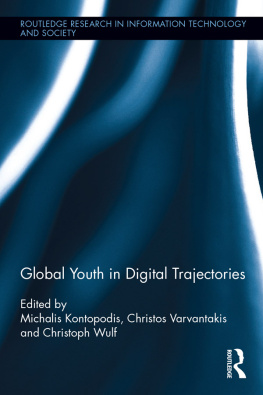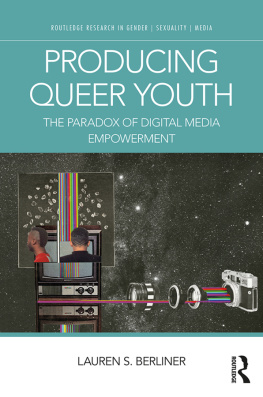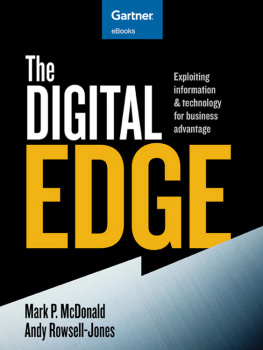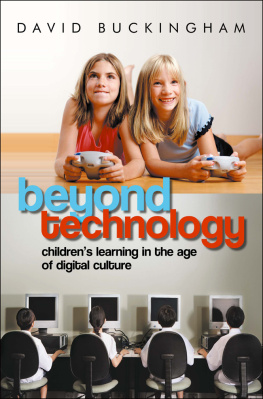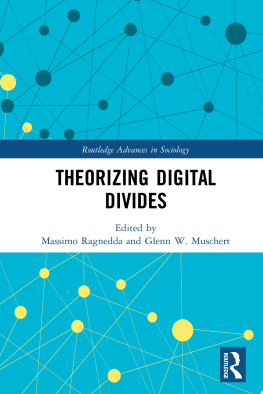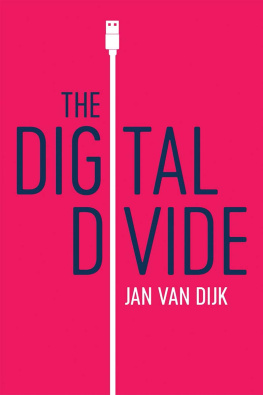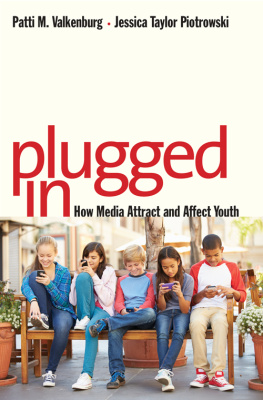Contents
Guide
Pagebreaks of the print version
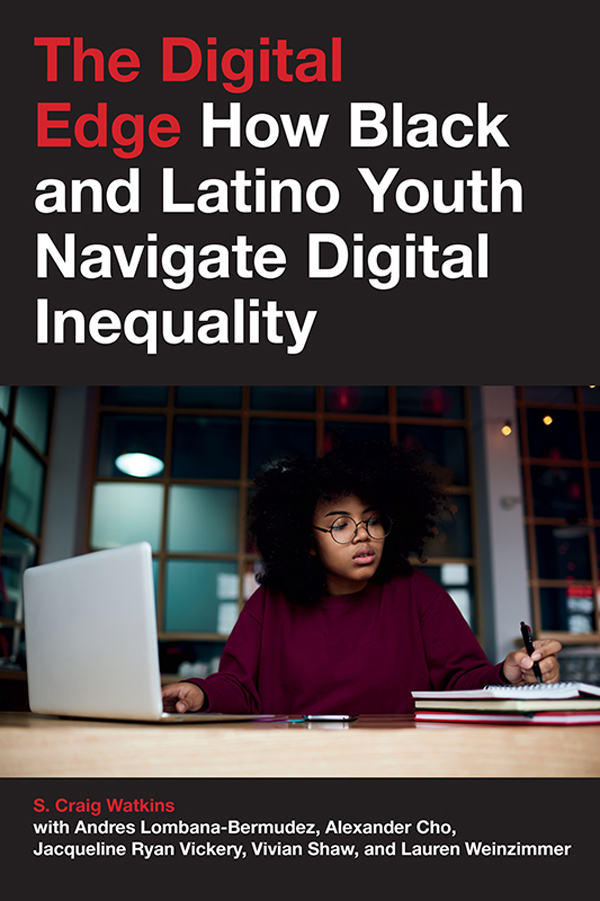
The Digital Edge
CONNECTED YOUTH AND DIGITAL FUTURES
Series Editor: Julian Sefton-Green
This series explores young peoples day-to-day lives and futures. The volumes consider changes at the intersection of civil and political reform, transformations in employment and education, and the growing presence of digital technologies in all aspects of social, cultural, and political life. The John D. and Catherine T. MacArthur Foundations Digital Media and Learning (DML) Initiative has supported two research networks that have helped launch this series: the Youth and Participatory Politics Research Network and the Connected Learning Research Network. The DML Initiative and the DML Hub at the University of California, Irvine, also support production and open access for this series.
connectedyouth.nyupress.org
By Any Media Necessary: The New Activism of American Youth
Henry Jenkins, Sangita Shresthova, Liana Gamber-Thompson, Neta Kligler-Vilenchik, and Arely Zimmerman
The Class: Living and Learning in the Digital Age
Sonia Livingstone and Julian Sefton-Green
The Digital Edge: How Black and Latino Youth Navigate Digital Inequality
S. Craig Watkins with Andres Lombana-Bermudez, Alexander Cho, Jacqueline Ryan Vickery, Vivian Shaw, and Lauren Weinzimmer
The Digital Edge
How Black and Latino Youth Navigate Digital Inequality
S. Craig Watkins
with Andres Lombana-Bermudez
Alexander Cho
Vivian Shaw
Jacqueline Ryan Vickery
Lauren Weinzimmer

NEW YORK UNIVERSITY PRESS
New York
NEW YORK UNIVERSITY PRESS
New York
www.nyupress.org
2018 by S. Craig Watkins
All rights reserved
References to Internet websites (URLs) were accurate at the time of writing. Neither the author nor New York University Press is responsible for URLs that may have expired or changed since the manuscript was prepared.
Library of Congress Cataloging-in-Publication Data
Names: Watkins, S. Craig (Samuel Craig), author.
Title: The digital edge : how Black and Latino youth navigate digital inequality / S. Craig Watkins [and five others].
Description: New York, NY : New York University Press, [2018] | Series: Connected youth and digital futures | Includes bibliographical references and index.
Identifiers: LCCN 2018021509| ISBN 9781479854110 (cl : alk. paper) | ISBN 9781479849857 (pb : alk. paper)
Subjects: LCSH: Digital divideUnited States. | Internet and youthUnited States. | African American youthSocial conditions. | Hispanic American youthSocial conditions. | Low income high school studentsUnited States. | EqualityUnited States.
Classification: LCC HN90.I56 W38 2018 | DDC 303.48/33dc23
LC record available at https://lccn.loc.gov/2018021509
New York University Press books are printed on acid-free paper, and their binding materials are chosen for strength and durability. We strive to use environmentally responsible suppliers and materials to the greatest extent possible in publishing our books.
Manufactured in the United States of America
10 9 8 7 6 5 4 3 2 1
Also available as an ebook
This book is dedicated to the students, teachers, parents, and guardians who welcomed us into their classrooms, homes, and lives.
Contents
S. Craig Watkins
S. Craig Watkins
S. Craig Watkins
S. Craig Watkins
Jacqueline Ryan Vickery and Vivian Shaw
S. Craig Watkins
S. Craig Watkins
S. Craig Watkins, Andres Lombana-Bermudez, and Lauren Weinzimmer
Alexander Cho, Vivian Shaw, and S. Craig Watkins
S. Craig Watkins
Alexander Cho, Jacqueline Ryan Vickery, Andres Lombana-Bermudez, and S. Craig Watkins
Preface
S. Craig Watkins
In 2010, just a year into Barack Obamas first term as president, the Presidents Council of Advisors on Science and Technology submitted an ambitious 142-page report that outlined the challenges and opportunities related to revitalizing science, technology, engineering, and math (STEM) education in the United States. The council operated from the widely accepted premise that the nation must redesign education for a world that is undergoing steady and profound social, economic, and technological change.
As president of the United States, Mr. Obama led several high-profile initiatives that were intended to bolster Americas technological and economic future by improving the quality of STEM education. The president consistently used his bully pulpit to rally educators, tech enthusiasts, industry leaders, and community activists around the movement to prepare the next generation of leaders in STEM.
Composed of leaders from tech giants such as Google and Microsoft, vice presidents from the National Academy of Sciences and the National Academy of Engineering, and university presidents, researchers, and scientists, the Presidents Council of Advisors on Science and Technology identified what it believed were the essential challenges to creating the educational strategy and school system the nation needed in a tech- and knowledge-driven economy. In its report to the president, the council wrote that to meet our needs for a STEM-capable citizenry, a STEM-proficient workforce, and future STEM experts the nation must focus on two complimentary goals: preparation and inspiration.
Many of the council members were intimately familiar with the rise and impact of intelligent machines and the increasing demand for highly skilled labor in the global economy and the U.S. workforce. The president had also emphasized the need to not only build the tech workforce of the future but ensure that it was inclusive and diverse. Accordingly, the council was attentive to the equity challenges in STEM and the startling lack of gender, racial, and ethnic diversity in the innovation economy. The report added, We must prepare all students, including girls and minorities who are underrepresented in these fields, to be proficient in STEM subjects. The council wrote that the nation must inspire all students to learn STEM and, in the process, motivate many of them to pursue STEM careers.
Among other things, the extensive report addressed the federal role in K12 STEM education, the need for improved standards and assessments, the importance of a well-trained corps of teachers, advances in educational technology, students, and school systems. Buoyed by a team of respected experts, data, and insights, the explanation of the problems prohibiting the creation and implementation of a more robust STEM curriculum was largely unassailable. However, among the thousands of sentences in the report, this one is especially peculiar: Despite its transformative role across the global economy, technology has not played a major role in K-12 education to date. The statement is peculiar largely because you could make a strong case that nothing has influenced public education more over the last thirty years than technological transformation. The tools and applications that have flowed into the classroomcomputers, smart boards, the Internet, mobile devices, tablets, social media, and advanced softwareinfluence how we deliver and even define education today. Since at least the 1990s there has been a persistent and largely uncontested view that every school must have computers and the Internet and that students should learn to use them.


